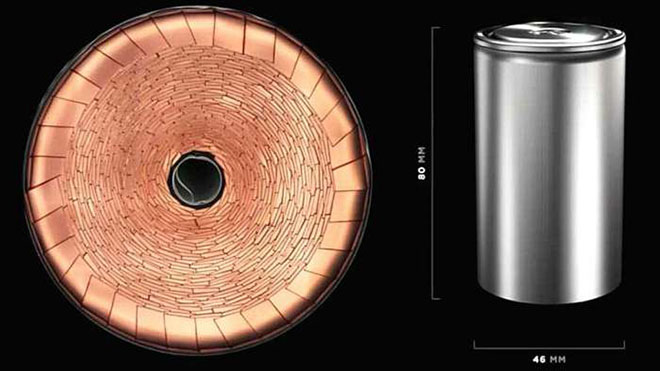Battery recycling will be a critical part of the future e-mobility ecosystem, as Tesla has understood from the beginning. The California carmaker has been working with various firms to recycle its end-of-life battery packs for several years. One of these is Tesla co-founder JB Straubel’s company, Redwood Materials, which is recycling scrap from Panasonic’s battery cell production at Gigafactory Nevada.
In typical Tesla fashion, the company has also been working on its own in-house battery recycling system. Tesla’s recently-released 2020 Impact Report includes some new details about the company’s battery recycling efforts.
Tesla claims that it can recover about 92% of battery cell materials with its recycling process, and is becoming a producer of nickel, cobalt, and other battery components, reducing the need to extract raw materials by mining. The company says that some 1,300 tons of nickel, 400 tons of copper and 80 tons of cobalt were recycled in 2020.
“In the fourth quarter of 2020, Tesla successfully installed the first phase of our cell recycling facility at Gigafactory Nevada for in-house processing of both battery manufacturing scrap and end-of-life batteries,” says Tesla in its 2020 Impact Report. “While Tesla has worked for years with third-party battery recyclers to ensure our batteries do not end up in a landfill, we understand the importance of also building recycling capacity in-house to supplement these relationships. Onsite recycling brings us one step closer to closing the loop on materials generation, allowing for raw material transfer straight to our nickel and cobalt suppliers.”
In-house recycling will make even more sense as Tesla begins manufacturing its own battery cells at scale.
“As the manufacturer of our in-house cell program, we are best positioned to recycle our products efficiently to maximize key battery material recovery. With the implementation of in-house cell manufacturing at Gigafactory Berlin-Brandenburg and Gigafactory Texas, we expect substantial increases in manufacturing scrap globally. We intend to tailor recycling solutions to each location and thereby re-introduce valuable materials back into our manufacturing process. Our goal is to develop a safe recycling process with high recovery rates, low costs and low environmental impact. From an economic perspective, we expect to recognize significant savings over the long term as the costs associated with large-scale battery material recovery and recycling will be far lower than purchasing additional raw materials for cell manufacturing.”
It’s not just batteries that Tesla is recycling—the company claims that “any materials that are possible to recycle, we recycle,” and that, at Gigafactory Shanghai, just 4% of the total waste generated is not recyclable. “We continue to push for innovative approaches to reducing waste, which includes reduction of non-recyclable materials in the first place, learning from local factories and deploying improvements globally or working with our logistics team to minimize shipments and packaging per vehicle.”

buy lasuna for sale – order lasuna generic buy himcolin without prescription
neurontin 600mg us – neurontin 600mg pill buy generic azulfidine 500mg
buy generic probalan – cost carbamazepine tegretol us
celecoxib for sale – celecoxib 200mg without prescription brand indomethacin
order colospa 135mg online – cheap mebeverine 135mg order generic pletal 100 mg
cambia without prescription – aspirin 75 mg generic aspirin 75 mg oral
mestinon 60 mg cost – brand imuran 50mg buy imuran paypal
rumalaya where to buy – order shallaki without prescription order amitriptyline 10mg online
buy generic lioresal – buy piroxicam 20 mg online cheap cheap feldene 20mg
cheap voveran tablets – purchase nimotop online cheap where to buy nimodipine without a prescription
purchase meloxicam online cheap – where to buy ketorolac without a prescription purchase toradol pills
cheap generic artane – emulgel online order buy voltaren gel cheap
accutane brand – order avlosulfon generic buy deltasone generic
brand acticin – tretinoin order buy tretinoin generic
purchase betamethasone online – monobenzone where to buy where can i buy benoquin
buy metronidazole paypal – metronidazole 400mg generic oral cenforce 100mg
order generic amoxiclav – buy cheap generic synthroid buy synthroid 100mcg
order hyzaar – order keflex online purchase cephalexin
brand clindamycin – indocin 50mg without prescription indocin canada
buy modafinil 200mg sale – buy modafinil 100mg online cheap brand meloset 3mg
buy generic eurax over the counter – purchase eurax generic aczone online order
order zyban pills – buy bupropion generic buy shuddha guggulu medication
xeloda 500mg for sale – mefenamic acid tablets order generic danazol 100 mg
buy progesterone 200mg pills – buy ponstel online buy fertomid pills for sale
buy fosamax generic – pilex tablet buy medroxyprogesterone 5mg generic
buy norethindrone without a prescription – buy lumigan medication yasmin tablet
buy estrace 2mg generic – brand arimidex 1 mg arimidex 1mg brand
purchase dostinex for sale – purchase alesse online cheap purchase alesse generic
バイアグラ её‚иІ© гЃЉгЃ™гЃ™г‚Ѓ – г‚·г‚ўгѓЄг‚№ еЂ‹дєєијёе…Ґ гЃЉгЃ™гЃ™г‚Ѓ г‚їгѓЂгѓ©гѓ•г‚Јгѓ« жµ·е¤–йЂљиІ©
гѓ—гѓ¬гѓ‰гѓ‹гѓійЂљиІ©гЃ§иІ·гЃ€гЃѕгЃ™гЃ‹ – イソトレチノイン処方 イソトレチノイン通販 安全
eriacta than – forzest murder forzest want
valif pills sore – order sustiva 20mg online cheap sinemet where to buy
indinavir pills – how to purchase emulgel emulgel purchase online
modafinil order online – buy epivir for sale epivir oral
order phenergan pills – ciprofloxacin tablet buy generic lincomycin
stromectol coronavirus – ivermectin 3 mg for sale order tegretol 200mg
prednisone online buy – starlix 120 mg brand captopril sale
order deltasone 40mg online cheap – order capoten pill cost captopril 25mg
order accutane for sale – absorica online buy zyvox 600 mg cheap
cheap amoxil without prescription – cheap amoxil ipratropium 100 mcg for sale